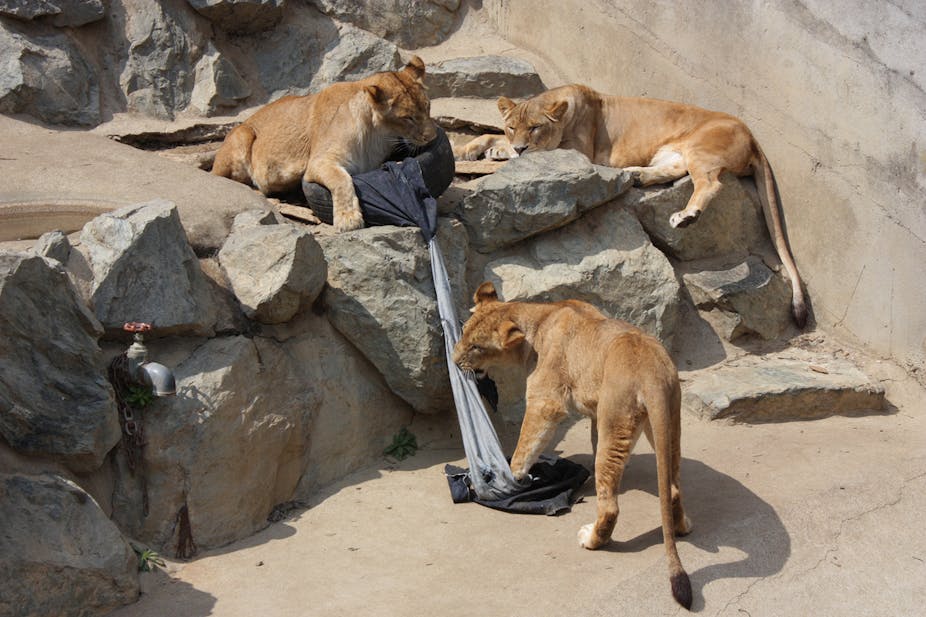A Japanese jeans maker has found a new way of capitalising on zoo animals. Zoo Jeans are producing jeans “designed by dangerous animals”. Denim is wrapped around tyres, which are then thrown to the lions who enjoy ripping and biting at the material. This produces that all-important designer, distressed look.
Rather than simply being a marketing gimic, there is actually value in this from an animal welfare perspective. Involving lions and the zoo’s other large carnivores in the activity is part of what’s called environmental enrichment. This is the provision of stimuli to help improve well-being. It’s a win-win activity for many zoos, who can make alternative profits from their animals, which tend to be used to provide extra facilities for them.
Wrapping denim around a tyre to make enrichment devices for toothy carnivores is just one way that zoos have profited from their animals’ hobbies over the years. Since their inception, zoos have looked for different ways to fund their activities. London Zoo when it first opened would let in penniless visitors for a cat or dog to be fed to the carnivores. Visitors with money were offered other things to keep themselves amused as they looked at the animals.
Rides, artwork and dung
One popular activity at zoos has been elephant rides, which expanded out to other animals. The Artis Zoo in Amsterdam used to offer paying visitors ostrich rides until one day when the ostrich took off with a hapless visitor on its back. The ride only ended some 10 miles from the zoo when the ostrich collapsed from exhaustion. These days, animal welfare and human safety regulations have rightly put an end to such animal rides in many countries.
Zoo Jeans’ use of zoo animals in its design process is not the first creative role that animals have played. Chimpanzees and elephants have been given paint brushes and blank canvases to create their own artwork. Perhaps the most famous example is Congo the chimpanzee, an artist admired by Pablo Picasso. He was introduced to art by zoologist Desmond Morris and, since his death, London Zoo has sold pieces by him for more than US$25,000. There has even been a chimpanzee art competition. I for one support this activity as the stimulus involved is enriching for the animals involved and the money made is fed back into their welfare.
Team building
Many zoos around the world have found a lucrative market in collecting the faeces of large carnivores for gardeners or foresters. Funnily enough, this isn’t a kind of luxury fertiliser. In fact, it’s to repel the small carnivores that roam our streets. Domestic cats and foxes communicate their presence in a territory by marking it with faeces and they recognise when this has been done by another member of their species or another carnivore. The system is like traffic lights, if the faecal matter of another individual or large carnivore is new then small predators read this as a red light but if it is old then it is green for go.

Thus, gardeners can spread lion or leopard dung around the borders of their garden to keep out unwanted small carnivores such as the neighbour’s moggy. Foresters can use this dung in a similar manner to protect trees from deer damage. But obviously the process needs to be frequently repeated; happily most zoos have a constant supply of said material.
A number of zoos have now gone into attracting corporate business clients and one of the things that always sells is team-building activities. Companies are given the task of building environmental enrichment devices for the zoo animal of their choice. The team has to choose an animal, observe it and then build it the object of its dreams. Once built, the newly made enrichment device is safety checked by a zookeeper, before being sent down the animal enclosure’s chimney.
Playing the role of Father Christmas for a giant anteater is more fun and challenging than you can imagine. Having spent much of my career working on environmental enrichment, I can tell you it is one of the most rewarding activities you can undertake with captive animals. It can also play an important role in helping revive zoos that are in decline.
Zoo Jeans are auctioning off their creations, with all profits going toward preserving the environment at their local zoo and the WWF.

